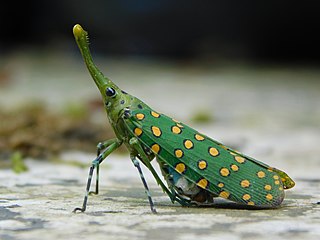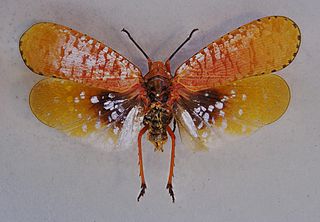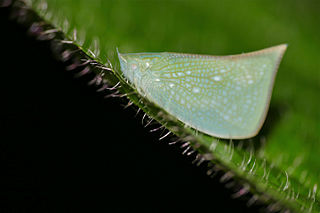
Saiva is a genus of Asian planthoppers, family Fulgoridae. They are colourful insects, marked boldly in red, blue, white and black, with a prominent slender stalk like structure arising on the head that points upwards or forward. The known distribution is from India, through Indo-China to Borneo.

Pyrops is a genus of planthoppers that occur primarily in southeast Asia, containing about 70 species. They are fairly large insects, with much of the length due to an elongated, upcurving, snout-like projection of the head. The wings are generally brightly patterned in contrasting colors, and they are popular among collectors.

The subfamily Aphaeninae is a group of hemipteran insects, especially abundant and diverse in the tropics. They belong to the Fulgoridae (fulgorids), though they are not among the better-known members of that family that are called "lantern bugs" or "lanternflies". In 2009, the first molecular analysis of the Fulgoridae challenged the existing structure of eight currently recognized subfamilies and eleven tribes.

Flatidae are a family of fulgoroid planthoppers. They are cosmopolitan in distribution and are distinguished from others in the superfamily by a combination of characters. Like all other planthoppers, they suck phloem sap of plants. Some species are known to communicate with vibrations through the plant stems. Communication may be with mates, or with ants that tend the nymphs, protecting them and gathering honeydew secretions. Adults of some species have brightly coloured forewings which are tougher and known as tegmina unlike the membranous hindwings which are used for flight. Although a few can be identified by their coloration, most species requires dissection and examination under a microscope with access to literature on already described species.

Issidae is a family of planthoppers described by Spinola in 1839, belonging to the order Hemiptera, suborder Auchenorrhyncha superfamily Fulgoroidea.

Nogodinidae is a family of planthoppers. They have membranous wings with delicate venation and can be confused with members of other Fulgoroid families such as the Issidae and Tropiduchidae. Some authors treat it as a subfamily of the Issidae.

Gergithus is a genus of tropical Asian planthoppers in the family Issidae, erected by Carl Stål in 1870. Like all planthoppers, adults feed on plant sap and are capable of escaping by leaping. The genus like other members in the tribe appears somewhat rounded and beetle-like, in some cases, with a mimetic resemblance to ladybird beetles. Species are mostly distributed in the Indomalayan Realm.

Calyptoproctus is a genus of planthoppers in the family Fulgoridae and the type genus of subtribe Calyptoproctina; records are from Central and South America.
The Elicini are a tribe of planthoppers in the family Tropiduchidae. The type genus is Elica.

Aphaena is a genus of planthoppers in the sub-family Aphaeninae of Fulgoridae. Species are distributed from eastern India, Indo-China, China and Malesia.

Hemisphaerius is a genus of bugs in the family Issidae and tribe Hemisphaeriini. Species resemble the closely related Gergithus: but are differentiated in this genus by the size of the frons and shorter legs.

The Hemisphaeriinae are a subfamily of bugs in the family Issidae, based on the type genus Hemisphaerius. Species in 119 genera have been recorded in most continents, but the greatest diversity appears to be in South-East Asia.

Eurybrachys is a genus of bugs in the family Eurybrachidae. First formally named in 1834 by French entomologist Félix Édouard Guérin-Méneville, Eurybrachys is the type genus of the family Eurybrachidae. The spelling Eurybrachis, by the author, is considered an unaccepted orthographic variant. Species in this genus occur in Asia.

Pochazia is a genus of true bugs belonging to the family Ricaniidae.

Tambinia is a genus of planthoppers (Hemiptera) in the family Tropiduchidae and typical of the tribe Tambiniini ; species are found in Australia and Southeast Asia.
Tropiduchus is a genus of planthoppers, recorded from Africa and Malesia.

Lawana is a genus of planthoppers in the family Flatidae, erected by William Lucas Distant in 1906. In 1923, Leopold Melichar confirmed placement of this genus in tribe Flatini and subtribe Lawanina. Species are recorded from tropical Africa and Asia.
Neosalurnis is a genus of planthoppers in the family Flatidae, erected by William Lucas Distant in 1910. It was subsequently placed in tribe Flatini, subtribe Phyllyphantina by Metcalf (1957) Records of occurrence are currently from Vietnam and China.

The Nogodininae are a sub-family of tropical planthoppers erected by Leopold Melichar in 1898. The recorded distribution is: South America, Africa and the Middle East, South and SE Asia through to Australia.
Goniopsarites is a genus of planthoppers in the tribe Pisachini in the family Nogodinidae, erected by Meng Rui, Wang Meng-Lin and Wang Ying-Lun in 2014. Species have been recorded from southern China and Vietnam.















